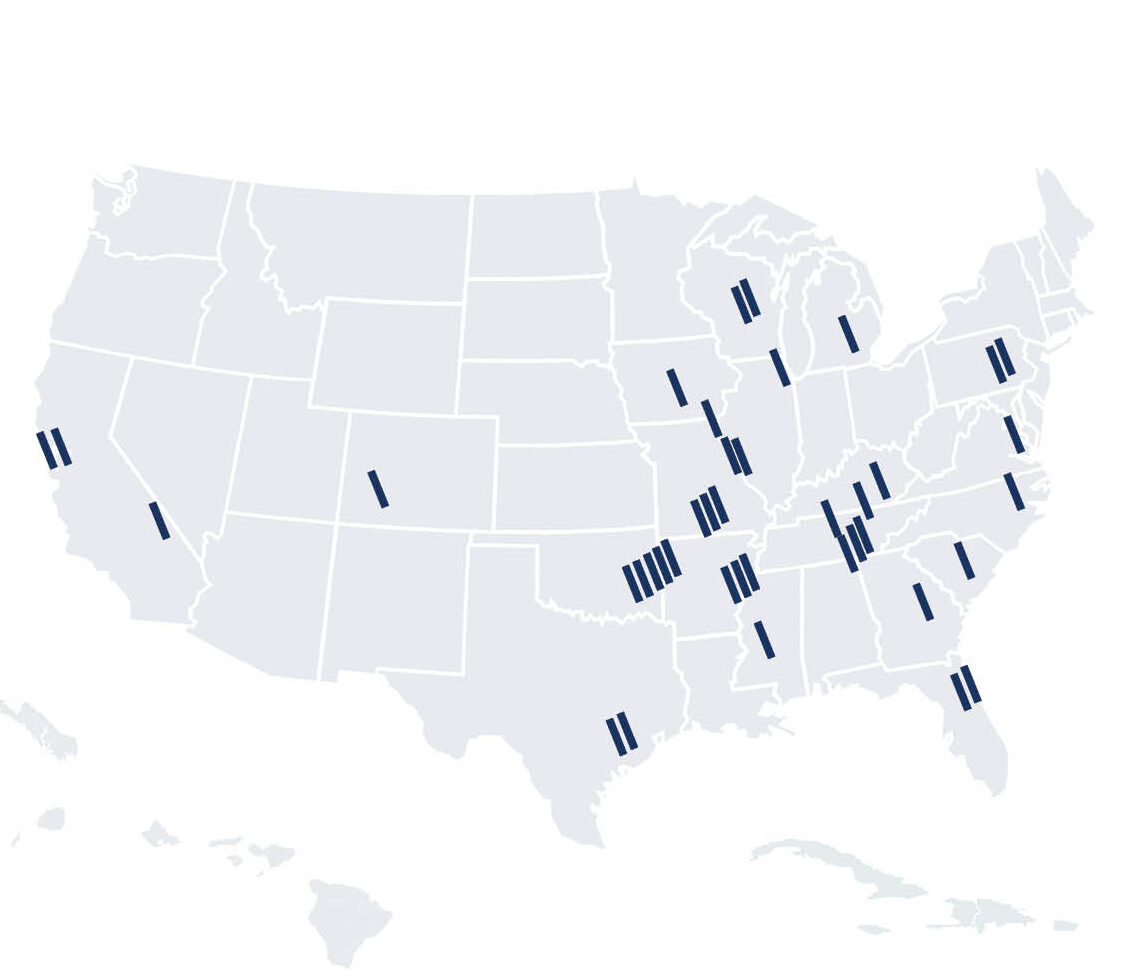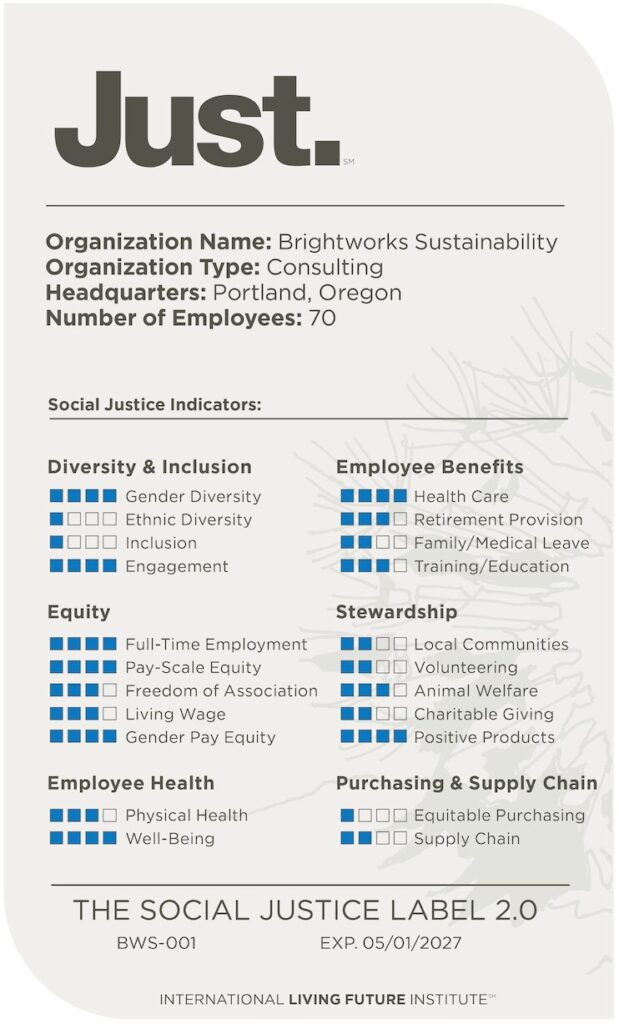Brightworks Earns Just Label 2.0
Raising the Bar Together: Brightworks Sustainability’s Just Label Journey
- Sustainable Built Environments
Practices Engaged

Raising the Bar Together: Brightworks Sustainability’s Just Label JourneySocial justice and equity in the workplace shouldn’t be an afterthought. They are core values that must be measurable, visible, and continuously improving. That’s why Brightworks Sustainability is proud to have completed Living Future’s Just label under version 2.0. Pursuing a Just label allows organizations to evaluate themselves through a social justice and equity lens by assessing a wide range of indicators including employee experience, well-being, health, and community connections. For Brightworks, the Just label process became a catalyst for codifying long-held values, identifying areas for improvement, and deepening the company’s commitment to transparency and employee support. Led by Managing Director Dawn Bergin, the Brightworks team saw the Just label not only as a benchmarking tool, but as a valuable way to reflect on and strengthen internal culture. In working toward the Just label, the team did more than tick boxes. They engaged deeply with the criteria, examined where practices already exceeded expectations and where they could be improved, and collaborated with external experts, including the Just team, to support more accurate, inclusive, and impactful use of the program in the future. Working towards achieving the Just label offered Brightworks a chance to not only measure practices and policies against the highest standards of organizational justice, but also an opportunity to provide input in the hope that they could shape those standards for the better.
A Culture of Transparency and AccountabilityThe Just label has often been described as a “nutrition label for your organization,” offering a clear, standardized way to communicate how a company performs on social justice and equity indicators. Not all the performance levels are realistically achievable – like Living Future’s other programs, the program imagines “what good looks like” at every stage. For Brightworks, the process was both affirming and illuminating. “As someone looking to build organizational culture, any tool that provides a different lens for self-reflection is helpful,” said Bergin. “We’re already doing a lot of internal cultural scanning, but Just gave us the ability to measure how we’re doing against best practices and norms, as well as an ideal state. It helped us find so many opportunities to make improvements, where doing a little bit more could make a difference.” Many Brightworks policies, such as commitments to local community investment, animal welfare, and access to vegetarian food options, were already in place but hadn’t been formalized or widely communicated. The Just process helped Brightworks document and share these values more clearly with staff. By offering a transparent framework for Brightworks’ operational processes, the Just label empowered Brightworks to take pride in its existing commitments and uncover new ways to advance equity and accountability. The Importance of a Living WageThroughout the process, team members including Bergin, Janell Eckes (Director of Human Resources), and other subject matter experts engaged in thoughtful conversations with the Just staff and external experts to provide constructive feedback on the label itself. In certain instances, Brightworks’ experience and practices exceeded what the current label recognized, prompting thoughtful discussions with Living Future staff about how the program could evolve. One notable example was the Living Wage category, which is based on data produced by the Living Wage Institute and made publicly available on the MIT Living Wage Calculator. When the team noticed that certain elements of total compensation weren’t factored into evaluating living wage compliance, they engaged directly with both researchers at the Living Wage Institute and expert staff working on the Just program to help clarify the link between living wages and benefits and to explore how the baseline living wage data can be more effectively applied to the label’s standard. “We’ve invested a lot of time and money into holistic benefits and compensation planning because we care a lot about this subject,” said Bergin. “The baseline living wage data, and by extension the Just Program’s living wage performance level, doesn’t fully capture these investments. We had a productive back-and-forth with the Living Wage Institute and Living Future staff to both improve the tool and help others better calibrate wages for employees in the future.” The Living Wage team noted that Brightworks’ feedback was an important input for further enhancing the Living Wage Institute’s employer-focused data products. The Living Wage Institute team currently offers more comprehensive compensation evaluations for companies seeking to complete the Just label, to provide clear guidance to those like Brightworks, who care deeply about employee experience and its intersection with both wages and benefits. Navigating the GapsWhile Brightworks found the Just framework to be a valuable tool for reflection and growth, the team also encountered other areas where higher performance levels were not achievable for the company. One example of this is how Just evaluates paid leave. “Brightworks is proud to offer 12 weeks of fully paid parental leave with the birthing parent receiving an additional 6-8 weeks for recovery from childbirth. This results in up to 20 weeks of fully paid leave,” said Eckes. This is no simple task for a small, national firm. Facing the complexity of having team members spread out over many states with varying, and sometimes no, state-provided paid family leave, Brightworks set a goal to provide a generous and consistent benefit across geographies. Brightworks achieves this by supplementing any state-paid parental leave the employee is eligible for with payments of up to 100% of the employee’s regular pay and has also partnered with a leave administrator to support the parents in navigating the state and insurance filings. “Brightworkers have consistently told us this was one of the most important benefits to them, so we dedicated resources to work through the complexities and put this expanded benefit in place,” noted Eckes. Even with this generous leave policy, Brightworks only qualified for two out of four performance levels. To reach the highest performance level, Just asks companies to offer 24 weeks of paid leave for employees experiencing the following circumstances: “Welcoming a child through birth, adoption, or foster placement or dealing with a serious health condition of their own or a loved one.” The expanded Brightworks benefit mentioned above is limited to parental leave, with other leave benefits and options available to those in need of medical leave; the additional benefit described in the 3rd and 4th level requirements were outside of Brightworks’ ability to offer. “We’re a smaller firm than most companies in our space and there are things we simply can’t afford to implement at our size and geographic presence,” explained Bergin. The Living Future team remained open to dialogue through this process. “The highest performance levels of the label are designed to reflect what good looks like,” said Program Manager Griso Barrios. “We understand that this ideal state may not be achievable by organizations today, and this is one area of the label that we did not change for version 3.0, but we have to challenge ourselves if we want (society) to get there.” Another was the Diversity and Inclusion category. While the company receives the highest possible performance level in this category through anonymous surveys and has a majority-female leadership team, Brightworks couldn’t earn full credit due to the demographic makeup of its ownership. “Even though we hit every other diversity and inclusion metric, our points were capped because of the way ownership is factored,” said Bergin. “It didn’t quite reflect our reality: a diverse broader leadership team and decision-making structure.” For instance, Brightworks makes decisions about project delivery and business development through staffed Councils, which are chaired by non-owners whose job roles are closely tied to the success of these functions. Both of these examples sparked good conversations, and the firm is looking forward to revisiting them at renewal in two years. Prioritizing Collective Bargaining and Employee VoiceBrightworks distinguishes itself through a long-standing commitment to collective bargaining and employee voice. In an industry where many firms “opt out” of this section of the Just label, Brightworks prides itself on freedom of association as part of its culture. The company has worked closely with staff to formally address requests for new programs like sabbaticals, KPIs for bonuses, and working towards creating a meaningful equity offering, as well as expanded parental leave and increased transparency and communication. Brightworks chose to complete version 2.0 of the label so this commitment could be fully reflected in the performance level achieved by the company in the relevant indicator that does not appear in version 3.0. That willingness to listen – and act – is central to Brightworks as an organization. The Just label process is helping bring even more transparency to those practices, while also prompting new conversations that help advance employee-centered policies. Looking AheadThe Brightworks team is proud of what the Just label reaffirmed: a strong, ongoing commitment to building a work culture where people feel valued, supported, and heard. “I loved engaging with experts and thoughtfully revisiting the process of thoroughly investigating our policies and compensation,” said Bergin. “I feel confident that we are providing the best support we can to our staff.” The team looks forward to making continued improvements to update and complete the label again. Thank you to Living Future and Just teams, who helped turn challenges into opportunities and welcomed feedback to strengthen the label for the future. Written by Corey Hastings, Marketing Consultant |


Starwood Hotels & Resorts
1 Hotel Hanalei Bay Luxury Resort
Starwood Hotels & Resorts
1 Hotel Hanalei Bay Luxury Resort
Princeville, HI
Brightworks provided LEED certification management and energy services to support Starwood Hotels with the major renovation and rebranding of Kauai’s Princeville Hotel into a flagship 1 Hotel resort focused on sustainable hospitality and wellness. Brightworks collaborated with the design and construction team to incorporate innovative strategies that will save energy and water, improve operations, and protect local ecosystems. Brightworks also delivered comprehensive energy modeling services, which allowed the project team to identify energy conservation measures and evaluate options.
Practices Engaged:
Sustainable Built Environments
Industry Sectors:
Hotel
Building Types:
Hotels & Resorts


Gerding Edlen
5 MLK Apartments
Gerding Edlen
5 MLK Apartments
Portland, OR
This biophilically-designed tower achieved LEED Gold and Fitwel 1 Star certification while also featuring a resiliency program. The building offers 100,000 square feet of offices on lower floors and 220 residential units with landscaped terraces above.
Practices Engaged:
Sustainable Built Environments, Healthier Built Environments
Industry Sectors:
Residential
Building Types:
Luxury Residential


City of Portland
Case Study
City of Portland
Case Study
Practices Engaged:
Healthier Built Environments
Industry Sectors:
Corporate, Government, State & Local
Building Types:
Historic Buildings
Read more


ABB
North American GreenCRREM Assessments
ABB
North American GreenCRREM Assessments
Arkansas, California, Florida, Georgia, Michican, Missouri, Mississippi, North Carolina, New Jersey, New Mexico, Oklahoma, Pennsylvania, South Carolina, Tennessee, Texas, Virginia, Wisconsin, West Virginia
ABB is a global leader in industrial technology. Across 17 states, Brightworks conducted sustainability assessments on more than 50 buildings in ABB's North American portfolio, including manufacturing, office, and warehousing facilities. An extensive report providing a baseline assessment for each site helped ABB prioritize energy efficiency measures, budget for carbon reduction efforts, and calculate ROI as part of its GreenCRREM program.
Practices Engaged:
Sustainable Built Environments, Carbon, Energy
Industry Sectors:
Corporate, Manufacturing


Salesforce
Case Study
Salesforce
Case Study
This letter to the industry highlights the urgent need to address embodied carbon in MEP/IT/AV systems. While operational emissions have seen progress, this embodied carbon remains a challenge. This article reveals insights to guide the industry toward a 50% reduction by 2030 to stay on track for meeting net-zero carbon targets for 2050.
Practices Engaged:
ESG + Corporate Sustainability, Sustainable Built Environments, Carbon, Materials
Read more


AI Meets Lower Carbon Concrete
AI Meets Lower Carbon Concrete
Concrete accounts for 8% of global GHG emissions, which is more than every country except the US and China. Lower carbon concrete is a critical climate solution, but designing it isn’t simple. While AI offers promise, experts warn of its limitations in capturing real-world variables. This post explores why human expertise still leads the way, and how integrative strategies are reshaping concrete’s future.
Practices Engaged:
Materials
Read more

-
U.S. GSA Diplomatic Security OfficeDiplomatic Security Office | Seattle, WA
-
U.S. Social Security Administration OfficeVan Nuys Office | CA
